#Jane Hackett
Text
Go at it.
#Mass Effect#Mass Effect 3#video games#gaming#Commander Shepard#John Shepard#Jane Shepard#David Anderson#Steven Hackett#The Illusive Man#Tali’Zorah#Garrus Vakarian#Urdnot Wrex#Liara T’Soni#Ashley Williams#Kaiden Alenko#James Vega#Miranda Lawson#Jacob Taylor#Jack#Urdnot Grunt#Zaeed Massani#Kasumi Goto#Samara#Thane Krios#Legion#Aria T’Loak#Destroy#Control#Synthesis
253 notes
·
View notes
Text
is there enough of an overlap of the quarry fans and ride the cyclone fans for there to be an au of it bc i think abt it
#the quarry#ride the cyclone#jacob custos#emma mountebank#abi blyg#nick furcillo#dylan lenivy#ryan erzahler#kaitlyn ka#laura kearney#max brinly#silas vorez#(i have specific thoughts abt talia and ballad of jane doe)#i just think that this au would be neat#the choir could totally survive hackett's quarry but the counsellors could not survive karnak
17 notes
·
View notes
Photo


365 Days of Six Queens
↳ Day 176 → Jasmine Hackett as Jane Seymour
7 notes
·
View notes
Photo

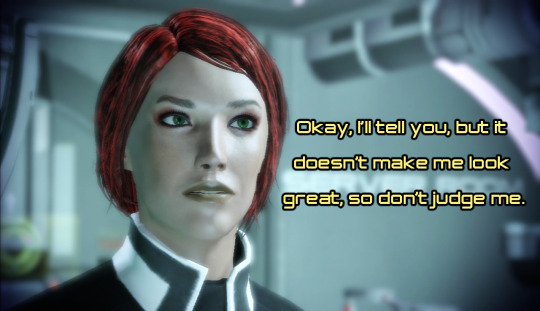

ME2/The good place
12 notes
·
View notes
Text
Goodbye, Breakaway 4.0 Queens
Today is the day the Breakaway 4.0 officially depart the ship.


These 6 principals have been nothing short of an honour to listen and watch grow.
Jade an absolute powerhouse, Jessie a sassy Boleyn, Jasmine a beautiful Seymour, Janice a chaotic Cleves, Lucia an innocent Howard and Elena a stunning Parr.

Finally, our alternate team (or the ones that will be leaving us anyway). We’ve loved seeing all your debuts and redebuts! Princess is such a strong Aragon, silly Boleyn and sassy Cleves. Ellie an incredible Seymour, young Howard and a beautiful Parr. Special mention to Meg, who was a rehearsal swing for the cast and the only rehearsal swing to not have returned thus far. Really hoping she gets a chance to return!
Thank you, Breakaway 4.0 queens!
#six the musical#six musical#six alternates#six#six chaos#six breakaway#six breakaway 4.0#jade marvin#jessie bodner#jasmine hackett#janice rjissel#lucia valentino#elena breschi#princess victome#ellie sharpe#meg dixon brasil#jane takes
3 notes
·
View notes
Photo

@/luciavalentino_ on Instagram, 6 November 2022
#six the musical#six breakaway 4.0#jasmine hackett#jessie bodner#princess victome#jade marvin#elena breschi#lucia valentino#jane best#sarah tompkins#mint parker
4 notes
·
View notes
Photo
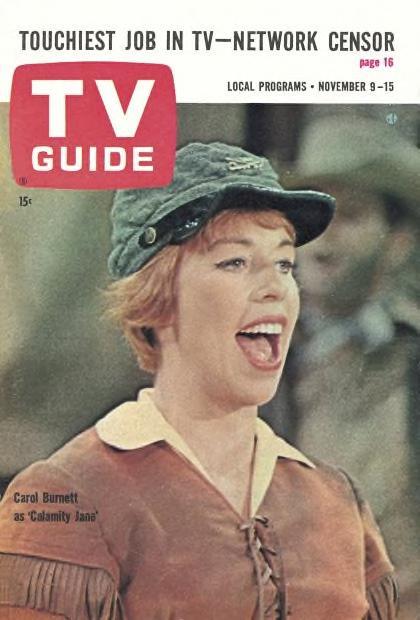
TV Guide - November 9 - 15, 1963
Carol Creighton Burnett (born April 26, 1933) Stage, film and television actress, comedian, singer, and writer, whose career spans seven decades of television. She is best known for her groundbreaking comedy variety show, The Carol Burnett Show, originally aired on CBS. It was one of the first of its kind to be hosted by a woman. She has achieved success on stage, television and film in varying genres including dramatic and comedic roles. She has also appeared on various talk shows and as a panelist on game shows. She would later have several daughters joining her in variety of American television series and films.
She was cast in a minor role on The Paul Winchell and Jerry Mahoney Show in 1955. She played the girlfriend of a ventriloquist’s dummy on the popular children’s program. This role led to her starring role opposite Buddy Hackett in the short-lived sitcom Stanley from 1956–57.
She worked as a regular on one of television’s earliest game shows, Pantomime Quiz, during this time. In 1957, just as she was achieving her first small successes, her mother died. In October 1960, Burnett debuted at New York’s Blue Angel Supper Club, where she was discovered by scouts for The Jack Paar Show and The Ed Sullivan Show.
In 1959 she became a regular player on The Garry Moore Show for the next three years, and won her first Emmy Award in 1962. Burnett had her television special debut in 1963 when she starred as Calamity Jane in the Dallas State Fair Musicals production of Calamity Jane on CBS. Burnett moved to Los Angeles, California, and began an 11-year run as star of The Carol Burnett Show on CBS television from 1967 to 1978. With its vaudeville roots, The Carol Burnett Show was a variety show that combined comedy sketches with song and dance. The comedy sketches included film parodies and character pieces. Burnett created many memorable characters during the show’s run, and both she and the show won numerous Emmy and Golden Globe Awards.
With her success on the Moore Show, Burnett finally rose to headliner status and appeared in the special Julie and Carol at Carnegie Hall (1962), co-starring with her friend Julie Andrews. She also guest-starred on a number of shows during this time, including The Twilight Zone episode “Cavender Is Coming”.
She became good friends with Jim Nabors, who was enjoying great success with his series Gomer Pyle, U.S.M.C. As a result of their close friendship, she played a recurring role on Nabors’ show as a tough corporal, later gunnery sergeant (starting with the episode “Corporal Carol”). Later, Nabors was her first guest on her variety show each season, as she considered him to be her good-luck charm. (Wikipedia)
51 notes
·
View notes
Text

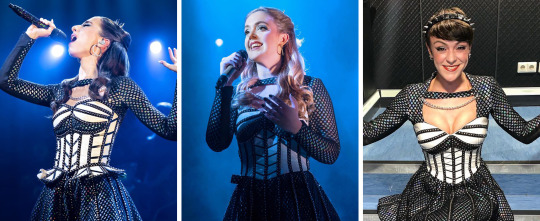
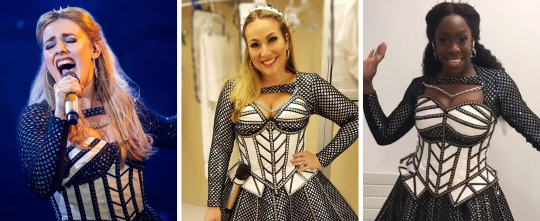








"Jane Seymour,
The only one he truly loved (Rude)
When my son was newly born I died
But I'm not what I seem, or am I?
Stick around and you'll suddenly see more"
[Holly Musgrave; Natalie Paris; Abby Mueller; Caitlin Tipping; Lauren Byrne; Amy Bridges; Loren Hunter; Gabriella Stylianou-Burns; Carly Mercedes Dyer; Elizabeth Walker; Wesley Carpenter; Claudia Kariuki; Casey Al-Shaqsy; Shelby Griswold; Keri René Fuller; Jasmine Forsberg; Ellie Wyman; Jasmine Hackett; Amina Faye; Kathryn Kilger; Bella Coppola; Hannah Taylor; Park Hye-na; Park Ga-ram; Erin Caldwell; Lucinda Wilson; Maggie Lacasse; Ruby Gibbs; Marta Burdynowicz; Viki Singh; Anna Peller; Kayleigh McKnight; Billie Kerr]
84 notes
·
View notes
Text
A Spectre's Proposal
Chapter 1

Pairing: f!Shepard/Kaidan Alenko
Rating: T
Chapter Length: 3.1K
Summary:
More than a year has passed since the Reaper War ended, and Kaidan and Jane have settled right into domestic life while they contribute to the rebuilding efforts on Earth. As normalcy begins to set in, so do old problems. News hits of piracy out in the Traverse when the Council calls on them for a secret mission only the two of them can fulfil. The nature of the mission leads them to think about what they want from their relationship.
Read the full chapter on AO3
Sample:
Jane woke up to her alarm in protest. She forced her eyes open despite wishing she could go back to sleep. It was a Tuesday. The worst day of the week. No longer rested from the weekend, and still with the majority of the week left to go.
This was never a problem she had on active duty. There was always so much to do that the days blurred together and the concept of regular sleeping hours was a fabrication. There was no such thing as a weekend, and they were lucky to get shore leave whenever it was granted. To have to wake up for a morning shift still felt so foreign, but here she was, still working the desk job that was assigned to her by Admiral Hackett almost exactly a year ago upon her return to Vancouver after the war. The only difference is that now it was a choice she made to stay here, rather than her only option.
When she was initially assigned the role, it was because her injuries from the war prevented her active status, but since then, she’d gone through rigorous physical therapy on top of her endurance and strength training. She ensured her certifications were up to date. She was fit for duty if she wanted it, but she and Kaidan decided they didn’t mind taking some time for themselves before getting back into it. It gave them a chance to reconnect without being pulled away on different assignments, desperate for some shore leave together. Being tied to a desk may not have been her first choice, but it granted them real and genuine time together, which was a gift she’d take a thousand times over.
As it was, there was no war to speak of, making the decision to stay at a desk a little more palatable, and this way, they got to carpool to work together. They ate lunch together most days and came home to each other every night. They went hiking up Grouse Mountain and went swimming in English Bay. And they even got to spend holidays with Kaidan’s family in the Interior. In fact, they’d be going back there soon for his sister’s one-year anniversary. Kaidan showed her Vancouver, and they took their time to appreciate life while still being able to contribute to the rebuilding efforts, of which there weren’t many left to speak of. Things were almost back to normal at this point. The relays were mostly repaired. The Citadel was back up and functioning in its new location over London. Things were better than she ever could have dreamed of, even if her job was a little monotonous and she hated waking to an alarm.
Jane was starting to feel sleep pull her under again when she finally fought against it. She’d spent enough time procrastinating in bed. Sun was already lighting up their room, and work beckoned. She turned over to see Kaidan’s side of the bed was already empty and tucked in as much as possible with her still sleeping on the other side. Jane smiled at the thought and how ingrained the habit was for him to do it even while she still occupied half the space. She stood up and tucked in her own side of the bed, not wanting to get a reputation for being the sloppy one, even though, of the two of them, she was definitely the one with that reputation already. When she was done, she went to take what was supposed to be a quick shower, and as with most mornings, she lost track of time. She got dressed in a hurry and ran to the kitchen. Her hair was still wet from the rush.
#f!shenko#f!shepard#kaidan alenko#mass effect fanfiction#fanfiction#mass effect#romance#fluff#fake engagement#my writing
16 notes
·
View notes
Text
Shadow Broker intercepted pt 2. Post Arrival DLC.
-
Subject(s): Tali’Zorah Vas Normandy, Garrus Vakarian, Jeff Moreau.
Location: Normandy SR2.
Mode: Text.
-
[BEGIN TRANSCRIPT]
19:22- TZ: is Shepard taking visitors yet?
19:22- JM: Nah. She’s always a monster after an injury, wouldn’t want to see her yet anyways
19:22- TZ: how bad is it?
19:22- GV: Hackett is a raging moron, if he pulls a stunt like this again…
19:22- JM: Bruised lung, third degree burns, concussion, a handful of gunshot wounds. Pretty typical for LC actually
19:23- TZ: Garrus try to talk to her, she’s not answering me
19:23- JM: Word of advice Big Guy—— DONT. She’ll rip you apart
19:23- TZ: don’t listen to him. for some unknown reason she has a soft spot for you
19:23- GV: i cant believe she followed that order. reckless and ridiculous
19:23- TZ: shut up and go
19:23- GV: fine
[END TRANSCRIPT]
—
SUBJECTS: GARRUS VAKARIAN, JANE SHEPARD
LOCATION: NORMANDY SR2
MODE: TEXT
—
[BEGIN TRANSCRIPT]
19:23- GV: any room in the medbay for your favourite turian?
19:23- JS: thought i already told you, Oraka’s my favourite turian.
19:24- GV: i know, but he couldn’t make it, sadly.
19:24- JS: pity
19:24- GV: so?
19:24- JS: no room
19:24- GV: bullshit
19:24- JS: sorry garrus
19:24- GV: cmon, everyone’s worried about you.
19:24- JS: fucking exactly. im not the victim here. this isn’t about me.
19:24- GV: people tend to worry when you leave a trail of blood leading to the medbay. I would know
19:25- JS: you’re worried about me? I’m blushing
19:25- GV: let me see?
19:27- JS: fine. get your flat ass over here.
19:27- GV: grumpy.
19:27- JS: bring my rations, im fucking starving
19:27- GV: Joker advised i stay away from you. He might’ve been right
19:27- JS: where’s my fucking food
[END TRANSCRIPT]
#mass effect#shakarian#arrival dlc#commander war crimes Shepard#garrus vakarian#tali’zorah#jeff joker moreau
101 notes
·
View notes
Text
Sip of Snips 1/7/24: Abrupt
Want to play? Check out the challenge here!
Here’s a bit from Stellar Parallax, Chapter 5: A Matter of Pride. Under the cut for crude language and a bit of violence.
─── ⋆⋅☆⋅⋆ ───
Three figures charged into the audience chamber. Jane had definitely killed somebody. An asari in white and blue armor leapt down from one of the balconies, landing with the same biotic corona Jane used. The Vindicator she leveled at Jane’s head didn’t faze his sister one bit. Behind the councilors, a salarian in black armor with yellow stripes uncloaked, omnitool at the ready to deploy god-only-knew what. And the third…
“Nihlus!” Saren took the stairs two at a time. “There you are. Maintenance called, someone broke out of Huerta Memorial of all places — vague physical description, as usual, humans are so—” He paused and took in the assembly of humans as if he would reconsider what he was about to say, then his icy gaze landed on Anderson. “Useless,” he sneered. “C-Sec lost the suspect on the Presidium, Blackwatch lost the suspect in the Tower, and now we need to go on lockdown, because I have somehow lost the little shit in the vents.”
“Human female?” Nihlus simpered. “Shorter than average, hospital gown, grippy socks?”
“Y. Yes, actually. How—”
Nihlus stepped aside. So he wasn’t corralling her. Was he protecting her?
Saren peered around his colleague’s bulk. Jane was baring her teeth at the asari. “Ah,” he acknowledged. “She’s awake.” Turning to the other two — they must have been Spectres as well — he waved a dismissal. “Vasir, Bau — crisis averted, it’s not a terrorist. I know this one.”
The salarian vanished, and only a moving shimmer gave away his exit. The asari still hadn’t broken eye contact with Jane. She blew a bubble — had she been chewing gum? She’d been chewing gum, and she looked bored.
John glanced at Nihlus. The Spectre winked and flicked his mandible. “She’s not gonna fuck you, Tela,” Nihlus snorted.
The asari didn’t break eye contact with his sister. “Who says that’s the logistical order?”
Sparatus cleared his throat. “Agent Vasir.”
Tela straightened up immediately. “Later,” she murmured to Jane on her way past.
“Bite me,” Jane snapped back.
Saren examined his talons and picked a stray fleck of— on second thought, John didn’t want to postulate further on what that fleck might have been. “Impressive, Shepard. Sloppy, but impressive.”
John furrowed his brow at Saren’s comment and pointed at himself.
The Spectre scoffed, briefly flaring his mandibles. “Not you,” he sneered. “Jane.”
Udina apparently decided it was the perfect evidence in his and Hackett’s favor. “See, Councilors! Even the racist prefers Jane!”
“Approval from Agent Arterius can only mean that it’s doomed from the start!” Anderson interjected.
Saren raised a talon. “Agent Arterius did not approve of anything, Agent Arterius was merely impressed,” he corrected. “But it’s nice to see I was right twenty years ago and David’s listening comprehension still hasn’t improved.”
Anderson was a big boy, he could defend himself. John had his own war to wage. “You really think you can be a Spectre with that kind of reckless behavior?” he shouted.
Jane’s smug face did nothing but stoke the flames, and then she poured gasoline on the fire. “Oh, is the Boy Scout angry he doesn’t get to be special anymore?”
“No, I’m angry because you refuse to see reason, and you’re going to get yourself killed!”
Hackett drowned out Jane’s reply as he went after Anderson. “How can you possibly turn down a better candidate, one that managed to get the approval of the longest-serving Spectre in history—”
“Again, not approval, simply impressed the pyjak could evade me in ‘grippy socks’—”
“— because of your own personal biases and failures! You have the gall to call me unprofessional while you stand there, practically committing treason!”
Anderson stepped into Hackett’s space, dwarfing the Admiral. “Treason? So now it’s treason to care about humanity’s image!”
Tevos finally lost her composure — not much, but her little chortle carried over the scuffles. “Humanity’s image,” she snickered.
“And what is that supposed to mean, Councilor?” Udina puffed up his chest, and if John hadn’t been contemplating strangling his own sister, he might have thought it was a little funny. Nihlus had no such engagement and very much did. “You want to talk, why don’t we talk about the *asari* image, hm?”
“You’re out of line, Ambassador,” Valern snipped, stepping in for his colleague.
A single, sharp krakk echoed around the Council chambers, silencing the lot of them.
“If we’re quite done shredding the unfortunate vau who’s been tossed into our playpen…” Sparatus huffed, a rolling growl rumbling like thunder in his throat and a smoking gun still raised above his head.
It was easy to forget how big their teeth were, how hard turians tried to stunt their emotional expression just to hide them. How intense their stares could be. Nihlus had already disarmed him, made him complacent through the easy smiles the Spectre handed out like samples and lackadaisical demeanor masking the cruel cunning underneath.
He’d already made John forget what he’d done down in the Wards.
John swallowed and fought the urge to shrink back under the deep, dark ocean in the Councilor’s eyes. Even with a combat diving certification, he knew there was no running from the sea. “I have better things to do than babysit eight grown adults and a shatha shaped like a human.”
Jane’s lip curled. Not helping.
“Saren, you’re without a student at the moment, aren’t you?” The lack of answer from Agent Arterius proved John’s theory that it wasn’t actually a question. The Councilor’s mandibles flicked as he tucked his pistol back into his suit jacket. “Congratulations,” he simpered, gesturing to Jane. “It’s a girl.”
“You can’t just—” Udina shut his mouth when that abyss was turned to him.
“I can,” Sparatus clipped. “And I did. Now humanity has two Spectres. Do my colleagues disagree?” The smile he gave them was a loaded gun. They both opted not to pull the trigger, shaking their heads. “Excellent, I’m glad we’re all on the same page. As John is handling the investigation into this… ‘prophet’ and whatever he had to do with Eden Prime and the threat to the Citadel, Jane’s evaluation will be an investigation into the ‘saviors’ he’s speaking of and their connection to the geth. That should take the two of you to opposite sides of the galaxy and everyone can be happy and leave me in peace with my lunch.”
John watched the Councilor walk away from the platform without another word. Without any further consideration about who he just granted extrajudicial authority to.
The other councilors filed out as well, with polite, civil dismissals the only thing either of them said after Sparatus took his abrupt exit. Neither of them fought it. They all witnessed Jane’s entrance, how… wild she looked, still half-dazed on sedatives and covered in gore. And they just agreed. They just gave the one person in the galaxy who shouldn’t have ever been given power at all, more power than any one person should ever possess, and the sole barrier of morality allegedly stopping her was Saren Arterius.
More rumors had surfaced about her exploits since Torfan.
He didn’t doubt a single one.
They were fucked.
─── ⋆⋅☆⋅⋆ ───
SoS Taglist: @sparatus @thetrashbagswasteland
Want to get tagged for this game specifically? Reply or message me, I’ll add you to the list!
4 notes
·
View notes
Note
Remember my ask about Charlize Theron? Alfonso Cuaron cast her in his new movie Jane, I'm excited :)
Huh... this film must be stuck in development, because this announcement article is from July 2022. It sounds like a really interesting project, so hope it actually gets made.
However, this made me look at how many credits as producer or executive producer she has. It's a ton more than I realized.
4 notes
·
View notes
Text
Happy Christmas in July!
Transcript below the break.
Hello and welcome back to the Rewatch Rewind! My name is Jane, and this is the podcast where I count down my top 40 most frequently rewatched movies in a 20-year period. Today I will be celebrating Christmas in July by discussing number 18 on my list: Liberty Films and RKO’s 1946 holiday classic It’s a Wonderful Life, directed by Frank Capra, written by Frances Goodrich, Albert Hackett, Frank Capra, and Jo Swerling, based on a story by Philip Van Doren Stern, and starring James Stewart and Donna Reed.
George Bailey (James Stewart) has always had big dreams of traveling and building things, but instead he’s stuck in his small hometown of Bedford Falls, New York, managing the family building and loan business. When his absent-minded Uncle Billy (Thomas Mitchell) misplaces $8,000 of company money, George feels that he is worth more dead than alive and plans to end his life on Christmas Eve, when he is stopped by Clarence Oddbody, Angel 2nd Class (Henry Travers) who has been sent from heaven to save him. George tells Clarence he wishes he’d never been born, so Clarence shows George what the town would be like without him.
As I’ve mentioned before, my family didn’t have a VCR in the ’90s, but we did sometimes watch movies together when they came on TV, so we caught It’s a Wonderful Life pretty much every year. I don’t know exactly how old I was when I first watched it, but I do remember being confused that it was in black and white. Once we finally got a VCR, we taped it one year so we could watch it whenever we wanted, and then eventually we got it on DVD. At some point we decided that it made a good Thanksgiving movie in addition to a Christmas one, since it’s about being grateful for what you have, so I tended to watch it once or twice a year for a while. I’d probably seen it about 10 times before I started keeping track, and then I saw it once in 2003, once in 2004, twice in 2005, once in 2006, three times in 2008, twice in each year from 2009 through 2012, and then once each in 2013 and 2014, and then once in each year from 2020 through 2022. I don’t remember exactly why I took such a long break after 2014, and I think it was probably a combination of factors, but I do remember reading an article probably around then arguing that Bedford Falls actually would have been more fun without George and that he should have gone to jail anyway that kind of ruined the movie for me a bit. While I recognize that there are legitimate criticisms to be made of the story and message and other details (such as the nonsensical decision to make AS2 the abbreviation for Angel Second Class), for me, the good definitely outweighs the questionable.
For one thing, the acting is superb. Everybody’s at the top of their game, with character actors such as Ward Bond, Frank Faylen, and Beulah Bondi doing some of their best work, and some very impressive child acting, particularly from Bobbie Anderson and Karolyn Grimes. Thomas Mitchell knows exactly when to play Uncle Billy’s memory issues for comic relief and when to reveal how devastating they can be. Henry Travers similarly gives the audience a perfect balance of chuckles and tears. Frequent femme fatale Gloria Grahame makes the initially shallow Violet Bick surprisingly sympathetic. The character of Mary Hatch Bailey is also deceptively simple on the surface, but Donna Reed brings her to life with so much warmth and depth and complexity that it takes several rewatches to fully appreciate her. Lionel Barrymore perfectly embodies the evils of capitalist corruption as Potter, in one of the most diabolical villain performances of all time. And then there’s James Stewart. My man Jimmy. I’m kind of surprised I haven’t had an opportunity to talk about him on this podcast before now, since he’s definitely one of my faves. His performance as George Bailey is SO. GOOD! Just thinking about it gives me chills. We see George go from a young man full of hopes and dreams to a frustrated, drained, broken middle aged man at the end of his rope, to a man trying to make sense of the reality of his non-existence who ultimately learns that he’s a better and more important person than he thought he was. It’s a major emotional roller coaster, and Jimmy Stewart absolutely nails every moment of the ride. It’s rare for a Hollywood film to let a male protagonist get anywhere near as emotionally raw and vulnerable as George Bailey is at several points throughout this film, but Stewart was clearly not afraid to cry on screen, and it’s beautiful to watch.
The sets and visual effects are also beautiful and noteworthy. Falling snow on film used to be created with cornflakes painted white, but a new snow effect using fire extinguisher foam mixed with soap and water was developed for It’s a Wonderful Life. Using this allowed the sound to be recorded live, which had been impossible with crunchy cornflakes, and I feel like it enhanced the performances to not have to record the dialogue separately. The Bedford Falls set was one of the longest sets that had ever been made for an American movie, and the streets and buildings do an excellent job of bringing the audience into the town. Apparently three different cinematographers worked on this movie (they kept getting fired due to disagreements with the director), but the look and feel of the film is remarkably consistent and unique. Plenty of movies set in small towns were made during this era, but somehow none of them feel quite like this one. That could just be my own nostalgia, since this was the first one I saw, but there’s just something about Bedford Falls that sets it apart from other movie settings, and that’s a big part of what I love about this movie. The sets and the lighting and the performances are so engrossing that no matter how many times I rewatch it, I still feel like I’m part of the town, and like I’m interacting with the characters, in a fresh and unique way.
It's interesting that I’m talking about two 1946 movies in a row because I think that, like Notorious, It’s a Wonderful Life could really only have been made that year. James Stewart had left Hollywood to fight in World War II and was considering giving up acting for good when Frank Capra asked him to star in this film. Capra had spent the war making documentaries and propaganda films, and this was also his first post-war movie. Now, I’ve never fought in a war, and my parents are baby boomers so I definitely wasn’t around for World War II, but it stands to reason that their wartime experiences significantly impacted the people involved in making this film and were still fresh on their minds. Stewart apparently said that his PTSD and depression from the war helped him relate to George Bailey, and that acting out George’s anger and frustrations was cathartic for him. The US was also at its most anti-fascist at this time, as James and I briefly discussed last week, which I assume is what allowed this movie to be so blatantly anti-capitalist. Building and Loan associations don’t really exist anymore, but based on my understanding of the Bailey business from this movie, they seem kind of like mutual aid mortgages. Because George holds onto this institution, the people of Bedford Falls are able to afford to buy decent homes for themselves. The alternative that Potter wants is everyone paying him exorbitant rent. By capitalist standards, George is a failure, and was incredibly foolish for turning down Potter’s lucrative job offer in the middle of the movie. But the film portrays him as a hero precisely because he values people over money. When he’s at the end of his rope, Potter has the power to save him (especially because he’s the one who has the cash that Uncle Billy lost) but he refuses; it’s George’s friends and family who rally around to help him. And that sounds like something that would have been considered dangerously close to socialism in the McCarthy era. The Hollywood blacklist started in 1947, so I feel like It’s a Wonderful Life couldn’t have been made even a year later than it was without significant modifications.
One of the main focuses of the story is the romance between George and Mary, but I feel like even that is used as a demonstration of the shortcomings of our capitalist society. They are clearly drawn to each other, but George initially tries to pretend otherwise, in large part because he doesn’t feel good enough for her. She has a college education; he does not. Their wealthy friend, Sam Wainwright, is interested in Mary, and George feels like she would be better off with Sam, even though all she wants is George. They spend all their honeymoon money on supporting Building and Loan clients during a bank run, at Mary’s suggestion, but George later regrets that he couldn’t afford to provide for both his clients and his wife. Mary is perfectly happy with their life, but George feels like a failure by society’s standards and can’t see anything else, so he needs Clarence’s reality check to show him that he has always been enough for her. If George wasn’t constantly being bombarded with the message that he should be making more money, that he should have been able to leave Bedford Falls and make something more of himself, that he should be able to buy his wife and children extravagant things, maybe he could have been happy without divine intervention.
But also we need to talk about what happens to Mary in the alternate reality when George doesn’t exist because I have some very mixed thoughts about that. Earlier, right after George turned down Potter’s offer, he asked Mary why she married a guy like him and she replied, “To keep from being an old maid.” So when George doesn’t exist, she is an old maid. I remember as a teenager who didn’t know that being aroace was a thing and didn’t want to examine why I only ever had “crushes” on celebrities who were already dead, thinking that Mary’s attitude made perfect sense: if you can’t marry Jimmy Stewart, why get married at all? The part that has always confused me is when George begs Clarence to tell him where Mary is, and Clarence says, “You’re not going to like it, George.” Wouldn’t he like it less if she had married someone else? Isn’t it good that she’s consistent with her assertions that he’s the only man for her? I like to think that Mary is on the aromantic spectrum, and feels romantic attraction so rarely that if she hadn’t met George she would never have felt it at all, but even I have to admit that the movie isn’t really trying to say that. It seems to be implying that Mary ending up a librarian with no husband is the worst possible fate for her, which is an infuriatingly amatonormative attitude for a story that otherwise encourages resistance to societal pressures. But overall, I give George and Mary’s romance a pass, because I do think they have a fascinating dynamic, and also because the movie focuses a lot on community and other non-romantic relationships too.
There’s a lot of emphasis on family relationships, and the brotherly bond between George and Harry that is slightly tinged with envy is particularly well done. Harry gets a lot of opportunities that George wants, but George chooses to be happy for and supportive of him rather than resenting him too much. And Harry’s toast at the end – “To my big brother, George, the richest man in town” – is one of the moments guaranteed to make me cry every time. When George is young, he kind of looks down on his father, but finally starts to appreciate him shortly before his death, although not quite enough to understand that it’s good that he follows in his father’s footsteps. His relationship with his mother is very sweet, and the part when she doesn’t recognize him is perhaps the most devastating moment in the movie. I really wish we got to see George interact with his children a bit more; we mostly see them when he’s taking out his work frustrations on them, which doesn’t seem like a typical interaction. His scene with Zuzu and the flower is adorable though. And then there are all the friendships. I don’t know if the Sesame Street characters were named after them, but Bert the cop and Ernie the cab driver have a fun relationship with each other and with George, and I appreciate that we get glimpses of how miserable they both are in the alternate reality. Violet is another interesting character, and at some points it almost seems like she’s being set up as a romantic rival for Mary, but she and George remain a rare good example of male/female friendship. And there are so many other great interactions between the townspeople; it feels like a real community. And it is that community of friends and acquaintances that come together at the end to help George and show him that he’s not alone, and that he has made a positive difference in all their lives. Granted, it’s very clear that Mary is the most important person to him, so the movie does reinforce the relationship hierarchy established by amatonormativity, but at the end, what does Clarence write in the book? “No man is a failure who has friends.”
I want to talk a little bit about representation in this film. There is only one black character, Annie, played by Lillian Randolph, who is, predictably, a maid, and while she is a pretty awesome character, she’s not in very much of the movie, and all the other characters are white. Disappointing, but not surprising for a 1940s Hollywood film. Similarly, while we get a few fabulous female characters, there are a lot more men than women. However, I feel like this movie has better disability representation than the average 2020s movie. It’s a Wonderful Life shows that it’s not that hard to incorporate an actor’s disability into a movie without it being the main focus of the story or the character. They really said, “You use a wheelchair? Awesome, your character uses a wheelchair now.” Of course, they were probably willing to provide more accommodations for the legendary Lionel Barrymore than they would have for an unknown disabled actor, but even he had been replaced in the 1938 film version of A Christmas Carol, in which he’d been slated to play Scrooge, because he couldn’t walk anymore. So I really like that It’s a Wonderful Life showed how effectively he could play a Scrooge-like character without walking.
I also really appreciate that It’s a Wonderful Life is very similar to A Christmas Carol, but kind of flipped. A Christmas Carol motivates the wealthy miser to change his behavior by showing him how happy people would be without him; It’s a Wonderful Life motivates the poor man to change his self-perception by showing him how unhappy people would be without him. A Christmas Carol’s message is that nobody is beyond redemption, which I do believe, but It’s a Wonderful Life responds with, “Let’s be realistic: the extremely rich aren’t going to change their ways; we need to do what we can to limit their power.” Which is a message that, if anything, has only gotten more relevant in the last 77 years. Most of my top 40 movies are fun, silly, entertainment that I use to escape the harshness of reality, but while this movie does have some fun moments, it’s less of an escape and more of a reflection of that harshness. I watch movies like Emperor’s New Groove and Mamma Mia and Bringing Up Baby and Ella Enchanted when I need to laugh; I watch It’s a Wonderful Life when I need to cry. Sometimes I have trouble regulating or understanding my feelings, and a big part of what I love about movies is the way they let us experience deep emotions in a relatively safe and controlled environment. It’s a Wonderful Life has been scorned by some film critics as overly sentimental, and perhaps it is, but I guess I don’t see anything wrong with being overly sentimental every once in a while. Sometimes you just need to feel feelings.
Thank you for listening to me discuss another of my most frequently rewatched movies. Next up is the shortest in a 4-way tie of movies I watched 22 times in the last 20 years, which is another one that I had seen many times before I started keeping track. As always, I will leave you with a quote from that next movie: “This is yet another example of the late neoclassic Baroque period. And, as I always say, ‘If it’s not Baroque, don’t fix it!’”
#it's a wonderful life#james stewart#donna reed#lionel barrymore#frank capra#the rewatch rewind#finally caught up on posting these!#sorry i got behind
3 notes
·
View notes
Text
JASMINE HACKETT OH MY FUCKING GOD SHES AMAZING SHES INCREDIBLE SHES SHOWSTOPPING AND SHE SINGS IN THE STUDIO KEY TOO?
her vocals and the studio key work so well wtf, and she’s definitely the first seymour to make me blubber and have to recover during haus of holbein
#six musical#six#six the musical#jasmine hackett#jane takes#jane listens#six cruise#six breakaway#btw never judge off a megasix is what these audios are teaching me xx#jasmine is so underrated and the megasix does not do her justice
5 notes
·
View notes
Text
quick rundown of my au verses ( so far ) ;

zombie apocalypse ; eleven never escapes the lab . she is brought up & trained there until zombie outbreaks start . they're kept holed up until either all the guards are dead or have fled to be with their families . upon escaping , eleven finds a group of people who exploit her for her abilities . they run her into the ground until she can no longer use her powers . once they realise this , they abandon her while she sleeps . she wakes up alone , with a zombie right on top of her & only her bare hands to fight it .
the quarry ; jane goes to hackett's quarry summer camp , but doesn't get on the bus back to civilisation . she's lost in the woods , unbeknownst to any of them . just days after everyone else has gone , jane is attacked by a creature they can't even begin to describe . they think they're dead , until they wake up with any wounds healed & feeling better than ever . soon , she is captured & put in the cages . she stays there , losing track of time until the next camp ends & being freed by jacob & ryan .
marvel ; eleven is created in a lab , by a scientist hell bent on taking down s.h.i.e.l.d . after attacking their headquarters , they see eleven's potential & put them into a rehabilitation program so they can fight on the ' right side ' .
6 notes
·
View notes
Text
DAYBREAK
1917
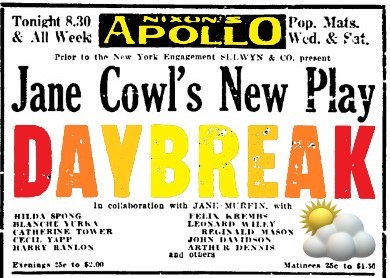
Daybreak is a play by Jane Cowl and Jane Murfin. It was originally produced by Selwyn and Company staged by Wilfred North and Miss Cowl.
Successful businessman Arthur Frome, who drinks too much, pushes a newsboy under an automobile, thus causing him severe injuries. His wife Edith then becomes disillusioned with her husband and leaves him. After an absence of a few years, Edith returns to her husband but offers no explanation of her behavior. Soon, however, Arthur becomes suspicious when she and their family friend, Dr. Brent, frequently visit a house in which a small child is living. Arthur has Edith followed by the wife of one of his employees, whom he has caught stealing, and soon discovers that the child, who is gravely ill, is his own. Edith confesses that she did not want to raise their child under the influence of a drunkard and so left him in someone else's care. Soon after this confession, Arthur is shot by the husband of the woman who has followed Edith because the man suspected his wife of having an affair. Arthur recovers, however, as does the child, and through Dr. Brent's intervention is happily reconciled with Edith, with whom he plans a new life.
About the Title: The play begins at daybreak in a darkened hallway of a New York apartment. Cowl and Murfin were intent on creating the mood of daybreak without resorting to clichés that might result in laughter. They nixed a visit from the milkman and a crowing rooster. They settled on a single shaft of yellow light piercing the darkness of the quiet room. The first scene is played in silence with no dialogue to create the ‘hush’ of early morning.
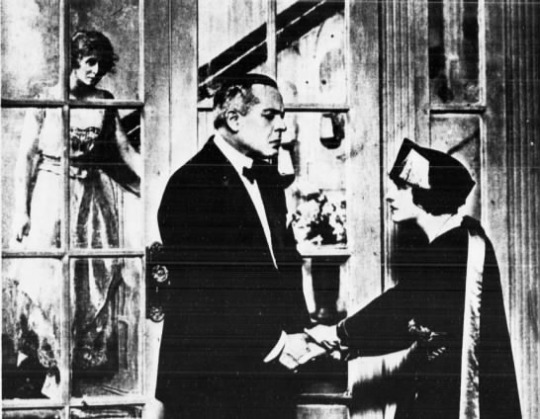
Daybreak premiered in Atlantic City at Nixon’s Apollo Theatre on the Boardwalk on June 18, 1917.
“[The play] was presented to early summer reporters at Atlantic City. It will not, therefore, be an unusual sight in Atlantic City to see a large number of people going home after ‘Daybreak'.” ~ WASHINGTON POST
Edith Frome was played by Blanche Yurka, a performer that Cowl had worked with and promised to help in her career. She was later cast in another play by Cowl and Murfin. Arthur Frome was played by Frederick Truesdell, one of Broadway’s most popular leading men.
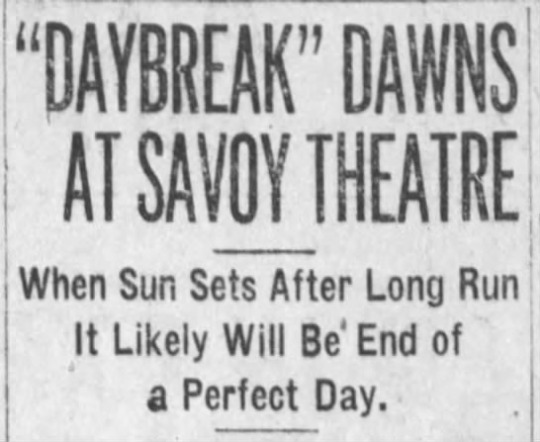
In late July and early August, the play was seen on the Jersey shore in Asbury Park at The Savoy and Long Branch at the Broadway.
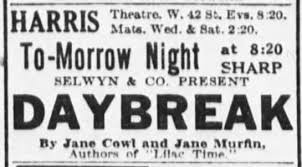
Daybreak opened on Broadway at the Harris Theatre (254 West 42nd Street) on August 14, 1917.
About the Venue: The Harris (named after William B. Harris) was built in 1904 as the Lew Fields Theatre. It was variously known as the Hackett, Wallacks, the Frazee, and finally the Anco Cinema. In 1988, the interior was gutted and it was used as retail space. It was finally demolished in 1997 as part of the 42nd Street redevelopment.

This was the second collaboration between Cowl (above) and Murfin, who previously penned Lilac Time earlier in 1917. Cowl also performed in Lilac Time, which closed on June 9th at The Harris (having transferred from The Republic), allowing Daybreak to move in. Between the two plays, Lilac Time proved the more popular and more successful. In October 1918 they collaborated on a third production, Information Please, with Cowl again performing, which was less successful still. In December 1919, the pair had their most successful script, Smilin’ Through, although they wrote it under the pseudonym Allan Langdon Martin. It inspired two films and two television adaptations. In 1932, Smilin’ Through was the basis for a flop musical titled Through The Years by Vincent Youmans.
"I am really pretty tired," she said. "You see, last summer was a strenuous one. I live at Great Neck on Long Island, and my movie work was done at Fort Lee NJ. I used to get up every morning at 5:30 am and shortly after after 6:30 I was in my car and on my way to Fort Lee. At 7 I was in my dressing room, by 8 I was in the studio. Then it was work until 5 or 6, with a short time off for lunch. Back to New York and rehearsals for "Daybreak,” my new play, until all hours. ~ JANE COWL, OCTOBER 7, 1917
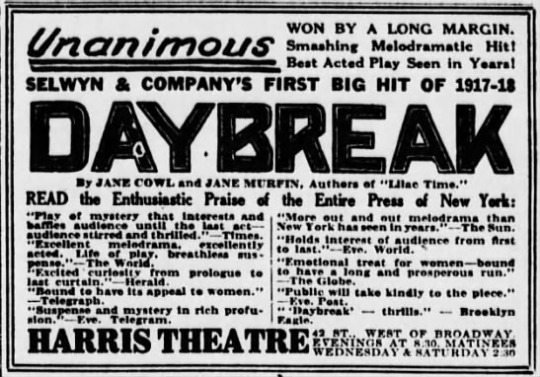
After the play was established on Broadway, Jane Cowl joined the road company of her Lilac Time. As of October 1917, Cowl was also seen on cinema screens in The Spreading Dawn (a title oddly similar to Daybreak), a civil war drama.
Daybreak closed on Broadway on October 13, 1917 after 71 performances.

Daybreak was filmed in 1918 starring Emily Stevens and Julian L’Estrange. It is now considered a lost film.
#Daybreak#Jane Cowl#1917#Jane Murfin#Selwyn & Co#Nixon's Apollo Theatre#Broadway#Broadway Play#Harris Theatre
18 notes
·
View notes